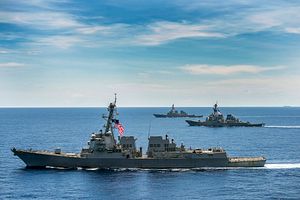“Mar-a-Lago” means “Sea-to-Lake.” Presidents Xi Jinping and Donald Trump may wish to note the name of Trump’s estate in Palm Beach where they are meeting to discuss U.S.-China relations. “Sea to lake” exactly describes what China is doing in Southeast Asia, as Beijing continues, unilaterally and coercively, to turn that body of water into a Chinese lake. The South China Sea is the maritime heart of Southeast Asia. The ongoing militarization of the sea’s land features clearly point to China’s desire to develop a network of armed bases for possible use in threatening Southeast Asia’s leaders into kowtowing to Beijing. China also hopes thereby to stop the United States from sailing through international waters that were patrolled by the U.S. Navy under the Obama administration — waters whose “high seas” status in and around the Spratly Islands was confirmed last year by an arbitral court convened under international law.
If this topic does not come up at Mar-a-Lago, or if it is relegated to the margins of the presidents’ conversation, Xi will return to Beijing confident that Trump is acquiescing in Chinese expansion. Xi may think he can give Trump a “win” to avoid Trump giving him a warning. By offering modest deliverables on economic relations, Xi may hope to give Trump a deflective “victory.” It would be deflective in that Chinese economic concessions, however minor, could be portrayed as Trump’s achievement — a success untainted by failure to make any progress on the South China Sea, let alone by a shouting match on that deadlocked topic.
Unfettered civilian and military access to the South China Sea by ship and air is in the American interest. It is not in that interest for China to selectively regulate such access, let alone foreclose it. Keeping this in mind, whether at the summit or after, Washington could and should encourage Southeast Asian and other countries, including China, to operate waterborne and airborne missions in and over the South China Sea — singly, among themselves, or in coordination with the United States. These missions could be, but need not be, military in nature. They could involve exercises in maritime safety, in ecological awareness, or in fisheries assessment, for example. The missions’ itineraries and activities would, crucially, comply with an operational map of the area that incorporates the July 2016 UNCLOS court’s ruling on the status of land features in the South China Sea. The map itself would be widely publicized in the littoral states and beyond.
Trump is hardly a fan of multilateral approaches. If he first raises the notion of “cooperative missions” in the South China Sea bilaterally with his Chinese counterpart, however, and the idea is rejected, it could then be socialized among other relevant states. A few or more of them could agree to proceed without China, much as some have already moved to “harvest” elements of the Trans-Pacific Partnership without the United States.
The 18 members of the annual East Asia Summit include the United States, China, Japan, India, Australia, and the ASEAN states. At Mar-a-Lago or later, the Trump administration could raise with China and other EAS members the idea of putting the above proposal for “cooperative missions” on the agenda of the 12th EAS, to be held in mid-November in the Philippines. A consensus to discuss the idea at that summit may be unreachable. But merely proposing it should trigger some reactions, pro or con. The airing of the idea would at least incentivize attention to the need for joint activities based on international law and discourage complacency in the face of unilateral coercion in violation of international law.
Developing the idea further, at least in think tanks if not foreign ministries as well, could also help to assure concerned Asian states that the United States is not abandoning the seaway to the suzerainty of any single power, and does not want play that sole-control role. Finally, merely raising, debating, and improving the idea might lead overconfident quarters in Beijing to question whether other countries, including China’s neighbors, will passively watch while China transitions the heartwater of Southeast Asia from “sea to lake.” The “Mar-a-Lago” coincidence should remain, after all, ironic not prophetic.
Professor Donald K. Emmerson heads the Southeast Asia Program at the Walter H. Shorenstein Asia-Pacific Research Center, Stanford University. See also his analysis on ASEAN’s future amid the South China Sea disputes.

































